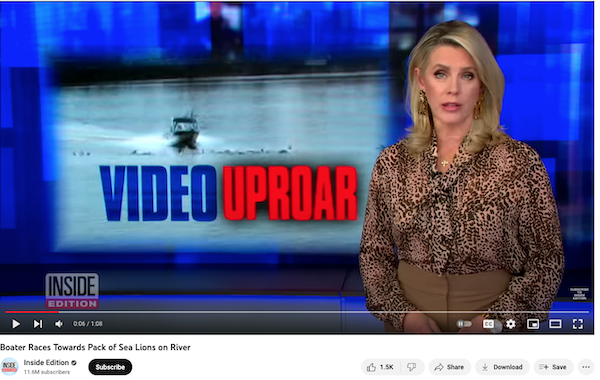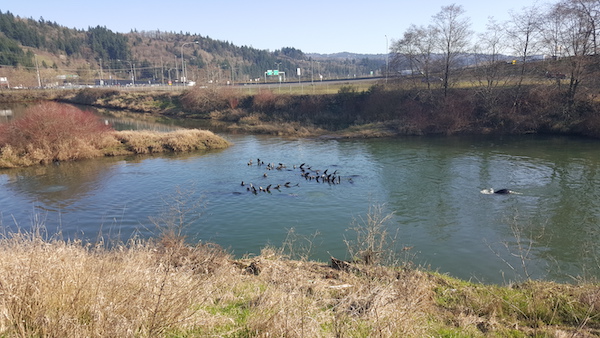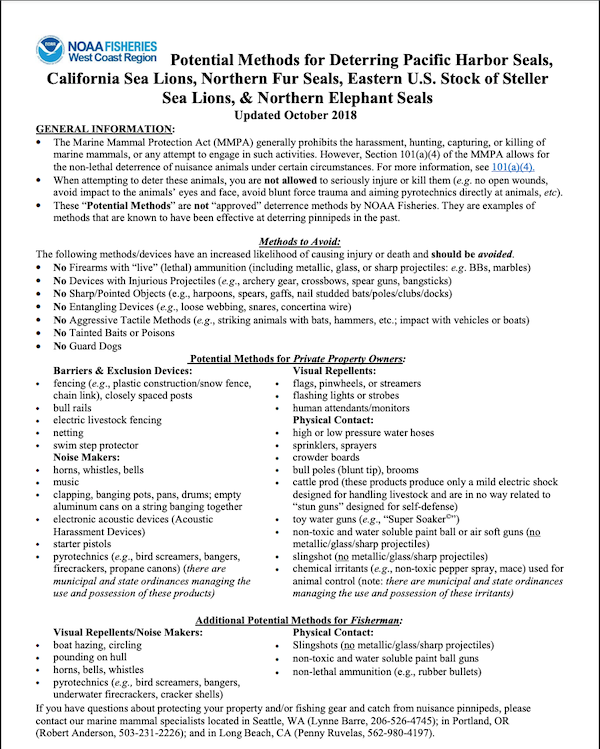
On Sea Lions And Swerves
So about Those Videos … you know the ones, pair of sportfishing boats slaloming toward packs of sea lions in the interstate stretch of the Lower Columbia earlier this week.
Made Portland, then Oregon, then national news. Won’t be long till it hits the BBC World Service.

In a place where cellphone cameras are as ubiquitous as sea lions, it’s … not the best look for fishermen.
Yeah, I know this post will get nothing but laughing-my-ass-off emojis, but while I have a general lifelong aversion to moralizing and preaching, the behavior in question doesn’t help with ongoing state, tribal and federal efforts to control the marine mammals in the least. Nor is it even remotely legal.
Do better.
OK, let me climb down now from my high horse.
Ahem.
If there is a bright side to the videos first collected by Portland station KGW, it’s that they also help illustrate and reinforce to the wider public that we have a pinniped predation problem in this massively, completely human-altered world that we ain’t going back from anytime soon.
Those sea lions in the videos are just a portion of those feeding on this year’s Endangered Species Act-listed smelt, spring Chinook and wild steelhead runs as the fish make their way up the big river, and some will stick around to devour sturgeon as well.
They’re like a huge gang of teenagers descending on your fridge and beer stash, then waiting around for your return from Costco with more.
These are all verifiably weak and at-risk fish stocks that provide widespread ecosystem benefits and, when and where there’s a surplus, fisheries.
Sturgeon aren’t federally listed like the others – at least not yet anyway – but there will be no retention season for them on the Lower Columbia this year and that’s because not enough juvenile fish are recruiting into the population.
Why not? A state sturgeon biologist told me that sea lions are “one major concern, directly through predation on sturgeon and indirectly by changing spawning sturgeon behaviors to avoid predation and either not spawn or spawn somewhere less suitable for eggs/larvae to survive.”
True, there are other, human-caused factors in play with diamondsides, but we also know about how sea lions are believed to be responsible for the majority of an estimated 20 to 44 percent of nonharvest mortality spring Chinook suffer as they make their way up the Lower Columbia to Bonneville Dam …
… And how, with sea lions gobbling as much as 25 percent of a likely Blob-weakened run, at least one Willamette River wild steelhead stock faced a nearly 90 percent risk of extinction if something hadn’t been done to curb their gluttony at the falls.
Just as with Herschel at the Ballard Locks with Lake Washington basin steelhead more than two decades before, nonlethal tactics weren’t working at the falls, but fortunately ODFW had the scientific data to be able to get a federal permit allowing for lethal removals of known, identified piscivores at that pinchpoint – 33 of the potential biological removal, or PBR, limit of 92 California sea lions in 2018-19, and 11 CSLs and one Steller sea lions since then – dramatically reducing the risk of extinction for winter-runs and easing it on springers as well.
Per the feds, CSLs have “fully rebounded” and reached their environment’s carrying capacity, while the eastern stock (or West Coast) stock of SSLs has been delisted from ESA.
Still, there’s the overarching and overly zealous Marine Mammal Protection Act, but the political will has been strong enough in Congress to amend it to grant state and tribal managers wider leeway in lethally removing sea lions in the Columbia and its salmon- and steelhead-bearing streams, with 87 CSLs and SSLs euthanized at Bonneville since 2020, building on the nearly 250 taken out between 2008 and that year.
The challenge is now taking that authority to other places on the system where pinnipeds are known to gather. Since early 2021, the DFWs have been collecting sea lion and seal sightings via an online reporting tool, and while that will help them narrow down where to trap, they’ll also need more federal funding to be able to build devices big enough to handle Stellers.
Paging the Northwest Delegation for a little more heavy lifting …

Government naturally moves slow, and when it comes to the MMPA and sea lions, Mother. Of. God. is it glacial. That was reinforced to me last month as WDFW honchos detailed where the agency was at in terms of building the scientific case and the generational-scale political will to do something about harbor seal predation of young Chinook in Puget Sound.
So in the meanwhile, for frustrated Portcouverland fishermen who are also finding springer angling slower than expected for this time of year, it can make it seem like the solution is to do some freelance high-speed sea lion hazing.
I mean, they’re always going to dive to safety rather than risk getting hit, but running on plane towards pods and forcing them underwater does not fall under NMFS’s allowable actions and sounds more like a “take.”
The feds actually made a list of do’s and don’ts.
We can use nonlethal ammo like rubber bullets, as well as pyrotechnics, paint balls and slingshots with certain projectiles, along with horns and jumping up and down on the boat hull, to dissuade harbor seals and sea lions from our gear or stealing fish off our line.
Of course, pinnipeds are smart buggers and those tricks have a shelf life; more than a few skippers now coach their crews not to stand while reeling in a fish and they only net the catch at the last moment, all in a bid to avoid pinniped piracy.

There’s also a curious entry in NMFS’s list – “boat hazing, circling” – that a few commenters suggested might cover the boaters’ actions.
Yesterday I asked Michael Milstein, an agency West Coast Region spokesman in Portland, about what boat hazing and circling might entail, and after he checked with federal law enforcement agents, he explained:
“Fishermen must be acting to protect their gear and/or catch. If gear is not deployed and fish are not in a net or on a line, harassment of pinnipeds could be considered unlawful ‘take.’ For example, fishermen might run a boat between a net and pinnipeds to deter them from taking the fish or getting entangled until the gear is retrieved.”
Multiple agencies are reportedly investigating the videos and the responsible parties could face stiff fines for that federal “take” violation.
“Our Office of Law Enforcement has the video and is asking anyone with information about the vessel or incident in the video to contact our law enforcement hotline at 800-853-1964 or use our website for reporting violations,” Milstein said.
Look, guys, I’m no sea lion lover, far from it, nor even a sea lion hater. They’re just a part of the management ecosystem anymore.
This is all to say that – for the time being at least – we do have tools to deal with them and to do so in a world that is also becoming more and more predator-friendly. That’s just a fact. Let’s not screw that up.
But the uptick in Chinook reports from the lower Lower Columbia, the coming four-day extension of the fishery and the fact that sea lions are going to be around in the river for awhile yet does have me worried we’ll see more swerving and more videos.
I just hope they show boaters going around instead of through packs. We don’t need to help anyone build a case against us and our access to fisheries, backtrack on being able to manage these marine marauders, or give ourselves another black eye.

